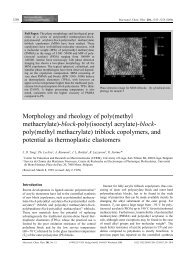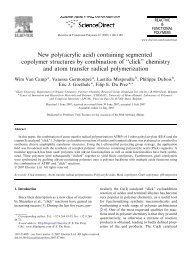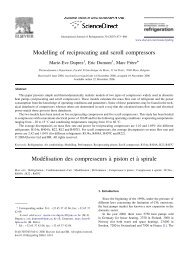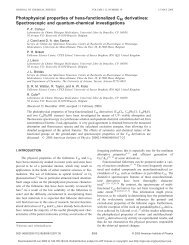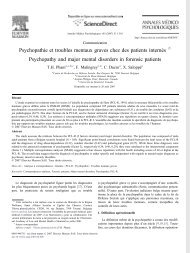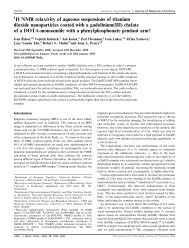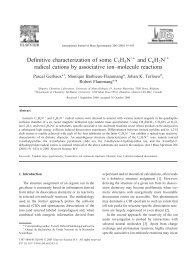<strong>Singlet</strong>–<strong>Singlet</strong> <strong>Annihilation</strong>Figure 5. Energy level diagram for PI-(pPh) 1 -PI and PI-(pPh) 2 -PI and the suggestedkinetic pathways; IC = internal conversion; fl = fluorescence.cantly, thus allowing, in addition, for a Dexter-type transfer.This effect could explain why the observed transfer is at least1000 times faster than predicted (rate constant 3.3 ” 10 9 s 1 )under the assumption of a Fçrster-type transfer within a3.4 nm distance between the centres of both transition dipolesand the observed emission and transient S 1 –S n absorptionspectra. However, the case of interaction between collinear dipolesat a separation distance comparable <strong>to</strong> the chromophoresize or shorter can no longer be treated under Fçrster approximations.Several studies have found a rate for energy transferfor these conditions that is faster than the one predicted bythe dipole–dipole interaction theory. [19–22] Also, for energytransfer of Zn porphyrins linked covalently <strong>to</strong> H2 porphyrins,the observed value of the rate constant exceeded that calculatedon the basis of the Fçrster equation. [23]A kinetic pathway similar <strong>to</strong> that outlined in Figure 5 couldbe expected <strong>to</strong> occur for PI-(pPh) 2 -PI for the deactivation ofthe energetically promoted excited chromophore. As indicatedby the transient absorption data, during the relatively slowtime course of the annihilation process (130 ps) the ultrafastprocess occurs at the same time, which results in difficult detectionof the charged intermediate. Furthermore, the efficiencyof the annihilation is substantially smaller (39 % according<strong>to</strong> the Fçrster theory for those molecules that did absorb twopho<strong>to</strong>ns), as revealed by the amplitude of the 130 ps component(20 %). Thus, the charge transfer process does not significantlyalter the population of the S 1 state that is moni<strong>to</strong>red inthe transient absorption. Thus, this process cannot be observed.ciently lead <strong>to</strong> a higher excited state, because the S 1 –S n absorptionband is shifted by 5340 cm 1 <strong>to</strong> the red part of thespectrum. The additional energy <strong>to</strong> reach this CT state must beobtained from the second excited chromophore via an ultrafastand efficient energy-transfer process. The conditions forsuch annihilation are favourable in terms of dipole distance,orientation and spectral overlap (see below). As a consequence,the donor S 1 state (2.4 eV) is quenched, and the chromophoreacting as energy donor reverts <strong>to</strong> the ground state.The energy-accepting chromophore is promoted in<strong>to</strong> a highersinglet excited state S n (4.09 eV), which then rapidly collapsesin<strong>to</strong> the singlet state with extensive CT character via internalconversion. Figure 5 shows the suggested energy level diagramand the kinetic pathway related <strong>to</strong> annihilation. The conversiontime of the S n state in<strong>to</strong> the CT state is beyond thetime resolution of our setup. This conversion is quantitative,which is reflected in the high amplitude of the anion andcation component, which are comparable <strong>to</strong> those formed inBZN. The annihilation as well as the CT state formation occurwithin an ultrashort timescale and are not resolved in the picosecondand subpicosecond time scale of these experiments.This ultrafast charge transfer suggests that the reaction isnearly barrierless. Direct excitation of the pPh moiety (400 nmexcitation wavelength) does not lead <strong>to</strong> a charge-transfer statebecause of a very rapid competitive energy transfer tha<strong>to</strong>ccurs <strong>to</strong>wards the ground state of the PI unit (see the SupportingInformation for details).This CT state in MCH is formed in a different way than theone observed in polar solvents. In the present case, an electronis transfered from a HOMO of the ACHTUNGTRENUNG(pPh) 1 <strong>to</strong> a deep-lying orbitalof the PI, which leads <strong>to</strong> a radical anion of PI and a radicalcation of ACHTUNGTRENUNG(pPh) 1 . Because all processes are much faster thanthe planarisation of the molecule, both chromophores are expected<strong>to</strong> overlap weakly during the sequence of annihilation,charge transfer and reverse transfer.Such an ultrafast exci<strong>to</strong>n–exci<strong>to</strong>n annihilation process is operationalin the case of the short separated chromophoresystem PI-(pPh) 1 -PI: as both excited S 1 states are delocalisedover the pPh moiety, their wavefunctions will overlap signifi-ConclusionsThe fem<strong>to</strong>second transient absorption experiments presentedhere clearly demonstrate that exci<strong>to</strong>n–exci<strong>to</strong>n annihilationoccurs upon high-power excitation in both molecular systemsinvestigated. These results are in line with previous studies andshow that energy transfer becomes faster and more efficientas exci<strong>to</strong>n coupling increases. This process leads <strong>to</strong> one chromophorebeing in a higher excited state, which then rapidlyrelaxes <strong>to</strong> S 1 via a charge-transfer state. The PI radical anion isformed in a low-polarity environment and decays with a timeconstant of about 1 ps. We have designed an experiment involvingan annihilation process that suggests an elegant way<strong>to</strong> explore reactions in the upper excited states, like in thiscase of an ultrafast charge transfer initiated above the lowestsinglet excited state. This approach could open the possibilityof further studies of the higher-excited-states properties ofchromophores.Experimental SectionMaterials and Steady-State Measurements: The synthesis and emissiveproperties of the two rigid pentaphenylene cores ACHTUNGTRENUNG(pPh) 1 andACHTUNGTRENUNG(pPh) 2 end-capped with two perylene monoimide chromphores(PI) and the compound PI-(pPh) 1 (used as a reference) have beenpublished previously. [28] The electron donor/accep<strong>to</strong>r capacity ofthe pPh and PI moieties are considered by the value of the oxida-ChemPhysChem 2007, 8, 1386 – 1393 2007 Wiley-VCH Verlag GmbH & Co. KGaA, Weinheim www.chemphyschem.org 1391
F. C. De Schryver et al.tion/reduction potentials (E ox = 1.31 V/E red = 0.875 V vs. Ag/AgClwith a ferrocene/ferrocenium internal standard in ace<strong>to</strong>nitrile solutioncontaining 0.1 m tetrabutylammonium perchlorate). [29]The steady-state absorption spectra have been recorded on aLambda 40 spectropho<strong>to</strong>meter (Perkin–Elmer) and the fluorescenceemission spectra on a Fluorolog I fluorimeter (SPEX). Tostudy the kinetic processes in a solvent of low polarity, PI-(pPh) 1 -PIand PI-(pPh) 2 -PI were investigated in methylcyclohexane (MCH). [30]The solvent provided by Aldrich was spectroscopic grade 99% andused as received. For the fluorescence experiments, the opticaldensity of all solutions was kept below 0.1 at the absorption maximumin a 1 cm cuvette. The excitation wavelength was set <strong>to</strong>495 nm. The fluorescence quantum yields of both compoundswere determined using Rhodamine B in ethanol as a reference (forl ex =495 nm). [31]Time-Resolved Experiments: The picosecond time-resolved measurementsof PI-(pPh) 1 -PI and PI-(pPh) 2 -PI were performed in MCH.All measurements were carried out in 1 cm optical path lengthcuvettes at an optical density around 0.1 at the excitation wavelengthof 483 nm, which is close <strong>to</strong> the absorption maximum. Thefluorescence decay times have been determined by the singlepho<strong>to</strong>n-timing(SPT) technique, which has been described in detailpreviously, [32] and the decays recorded were analysed globallyusing a time-resolved fluorescence analysis (TRFA) software. [33]The fem<strong>to</strong>second time-resolved measurements were performedwith an amplified fem<strong>to</strong>second double optical parametric amplifier(OPA) laser system, which has also been described previously. [34]The entire system provides pulses with a duration of 300 fs (fullwidth-at-half-maximumcross-correlation between pump andprobe) and covers a wavelength range between 400 nm and750 nm. Having established that more than one pho<strong>to</strong>n can be absorbedby the same molecule during the same pulse (absorptioncross-section at 495 nm s A = 1.98”10 16 cm 2 ), the fem<strong>to</strong>secondtransient absorption experiments were performed at three excitationpowers <strong>to</strong> reveal possible multichromophoric processes (60,120, and 400 mW; the highest value was still below saturation).Deoxygenation of the samples was carried out by consecutivefreeze–pump–thaw cycles. The sample was in a quartz cuvettewith an optical path length of 1 mm and was probed by pulses polarisedunder the magic angle (54.7 0 ) relative <strong>to</strong> the pump-light polarisationplane. The compounds were dissolved in MCH at a concentrationthat yielded an absorbance of around 0.4 per mm at theexcitation wavelength of 580 nm. To improve the signal-<strong>to</strong>-noiseratio, every measurement was averaged over 15 times at each ofthe 512 delay positions. After each experiment, the integrity of thesamples was checked by recording the steady-state absorptionand emission spectra and comparing them with those obtainedbefore the experiments. No spectral changes suggesting pho<strong>to</strong>degradationwere observed. To obtain all different kinetic components,all monochromatic transient absorption traces were globallyanalysed over two time windows of 50 and 420 ps. The nanoseconddecay times of the components found in SPT experimentswere kept fixed during the fit procedure.AcknowledgementsSupport from the FWO, the Flemish Ministryof Education (GOA2001/02, GOA 2006/2), the IWT through ZWAP 04/007 and theBMBF, the Federal Science Policyof Belgium (IAP-V-03; IAP-VI-27)is acknowledged. A Max Planck research award and an Eurocoresgrant (Bionics) are also acknowledged.Keywords: annihilation · charge transfer · chromophores ·fem<strong>to</strong>chemistry · time-resolved spectroscopy[1] a) M. Dahan, A. A. Deniz, T. J. Ha, D. S. Chemla, P. G. Schultz, S. Weiss,Chem. Phys. 1999, 247, 85 – 106; b) J. B. Birks, Pho<strong>to</strong>physics of AromaticMolecules, Wiley, New York, 1970.[2] a) J. Larsen, B. Bruggemann, T. Polivka, V. Sundstrom, E. Akesson, J. Sly,M. J. Crossley, J. Phys. Chem. A 2005, 109, 10654 –10662; b) R. M. Pearlstein,Pho<strong>to</strong>synth. Res. 2002, 73, 119 –126.[3] D. Gust, T. A. Moore, A. L. Moore, Acc. Chem. Res. 2001, 34, 40 –48.[4] a) J. Larsen, B. Bruggemann, J. Sly, M. J. Crossley, V. Sundstrom, E. Akesson,Chem. Phys. Lett. 2006, 433, 159 –164; b) J. Hofkens, M. Maus, T.Gensch, T. Vosch, M. Cotlet, F. Kohn, A. Herrmann, K. Müllen, F. DeSchryver, J. Am. Chem. Soc. 2000, 122, 9278 –9288; c) A. J. Gesquiere,Y. J. Lee, J. Yu, P. F. Barbara, J. Phys. Chem. B 2005, 109, 12366 – 12371.[5] a) M. Fujitsuka, M. Hara, S. Tojo, A. Okada, V. Troiani, N. Solladie, T.Majima, J. Phys. Chem. B 2005, 109, 33 –35; b) S. Masuo, T. Vosch, M.Cotlet, P. Tinnefeld, S. Habuchi, T. D. M. Bell, I. Oosterling, D. Beljonne, B.Champagne, K. Müllen, M. Sauer, J. Hofkens, F. C. De Schryver, J. Phys.Chem. B 2004, 108, 16686 –16696; c) I. B. Martini, A. D. Smith, B. J.Schwartz, Phys. Rev. B 2004, 69, 035204.[6] a) Q. H. Xu, D. Moses, A. J. Heeger, Phys. Rev. B 2003, 68, 174303;b) T. D. M. Bell, S. Habuchi, S. Masuo, I. Osterling, K. Müllen, Ph. Tinnefeld,M. Sauer, M. Van der Auweraer, J. Hofkens, F. C. De Schryver, Aust. J.Chem. 2004, 57, 1169 – 1173.[7] a) J. Moll, W. J. Harrison, D. V. Brumbaugh, A. A. Muenter, J. Phys. Chem.A 2000, 104, 8847 –8854; b) M. Cotlet, T. Vosch, S. Masuo, M. Sauer, K.Müllen, J. Hofkens, F. C. De Schryver, Progress in Biomedical Optics andImaging, Proc. SPIE 2004, 11, 20 –28, 1605 –7422.[8] a) J. M. Lup<strong>to</strong>n, A. Pogantsch, T. Piok, E. J. W. List, S. Patil, U. Scherf,Phys. Rev. Lett. 2002, 89, 167401; b) J. Hofkens, M. Cotlet, T. Vosch, P. Tinnefeld,K. D. Wes<strong>to</strong>n, C. Ego, A. Grimsdale, K. Müllen, D. Beljonne, J. L.BrØdas, S. Jordens, G. Schweitzer, M. Sauer, F. C. De Schryver, Proc. Natl.Acad. Sci. USA 2003, 100, 13146 –13151.[9] T. Vosch, M. Cotlet, J. Hofkens, K. Van der Biest, M. Lor, K. Wes<strong>to</strong>n, Ph.Tinnefeld, M. Sauer, L. Latterini, K. Müllen, F. C. De Schryver, J. Phys.Chem. A 2003, 107, 36, 6920 – 6931.[10] Ph. Tinnefeld, J. Hofkens, D.-P. Herten, S. Masuo, T. Vosch, M. Cotlet, S.Habuchi, K. Müllen, F. C. De Schryver, M. Sauer, ChemPhysChem 2004, 5,1786 –1790.[11] E. Fron, T. D. M. Bell, A. Van Vooren, G. Schweitzer, J. Cornil, D. Beljonne,P. Toele, J. Jacob, K. Müllen, J. Hofkens, M. Van der Auweraer, F. C. DeSchryver, J. Am. Chem. Soc. 2007, 129, 610 –619.[12] a) F. C. De Schryver, T. Vosch, M. Cotlet, M. Van der Auweraer, K. Müllen,J. Hofkens, Acc. Chem. Res. 2005, 38, 514 –522; b) G. De Belder, G.Schweitzer, S. Jordens, M. Lor, S. Mitra, J. Hofkens, S. De Feyter, M. Vander Auweraer, A. Herrmann, T. Weil, K. Müllen, F. C. De Schryver, Chem-PhysChem 2001, 2, 49 –55.[13] K. Becker, J. M. Lup<strong>to</strong>n, J. Am. Chem. Soc. 2006, 128, 6468 – 6479.[14] K. Becker, J. M. Lup<strong>to</strong>n, J. Feldmann, S. Setayesh, A. C. Grimsdale, K.Müllen, J. Am. Chem. Soc. 2006, 128, 680 –681.[15] M. Lor, S. Jordens, G. De Belder, G. Schweitzer, E. Fron, L. Viaene, M.Cotlet, T. Weil, K. Müllen, J. W. Verhoeven, M. Van der Auweraer, F. C. DeSchryver, Pho<strong>to</strong>chem. Pho<strong>to</strong>phys. Sci. 2003, 2, 501 – 510.[16] M. Lor, J. Thielemans, L. Viaene, M. Cotlet, J. Hofkens, T. Weil, C. Hampel,K. Müllen, J. W. Verhoeven, M. Van der Auweraer, F. C. De Schryver, J.Am. Chem. Soc. 2002, 124, 9918 –9925.[17] M. A. Izquierdo, T. D. M. Bell, S. Habuchi, E. Fron, R. Pilot, T. Vosch, S. DeFeyter, J. Verhoeven, J. Hofkens, F. C. De Schryver, J. Jacob, K. Müllen,Chem. Phys. Lett. 2005, 401, 503 –508.[18] E. Fron, M. Lor, R. Pilot, G. Schweitzer, H. Dincalp, S. De Feyter, J.Cremer, P. Bäuerle, K. Müllen, M. Van der Auweraer, F. C. De SchryverPho<strong>to</strong>chem. Pho<strong>to</strong>biol. Sci. 2005, 4, 61 –68.[19] H. Wiesenhofer, D. Beljonne, G. D. Scholes, E. Hennebicq, J.-L. BrØdas, E.Zojer, Adv. Funct. Mater. 2004, 14, 155 – 160.[20] H. Singh, B. Bagchi, Curr. Sci. 2005, 89, 1710–1714.[21] J. C. Chang, J. Chem. Phys. 1977, 67, 3901–3909.[22] a) C. G. Hübner, G. Zumofen, A. Renn, A. Herrmann, K. Müllen, T. Basche,Phys. Rev. Lett. 2003, 91, 093903; b) R. R. Chance, A. Prock, R. Silbey, J.1392 www.chemphyschem.org 2007 Wiley-VCH Verlag GmbH & Co. KGaA, Weinheim ChemPhysChem 2007, 8, 1386 – 1393



